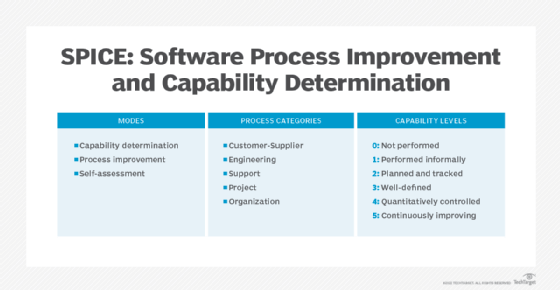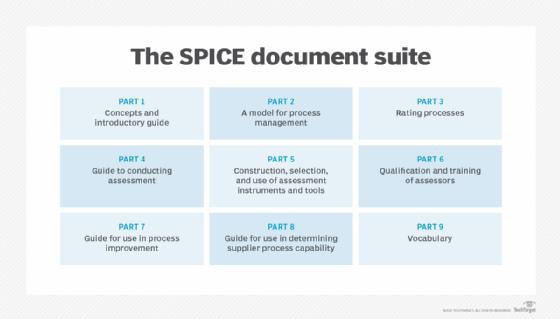Software Process Improvement and Capability Determination (SPICE)
What is Software Process Improvement and Capability Determination (SPICE)?
Software Process Improvement and Capability Determination (SPICE) is an international framework to assess software development processes. SPICE was developed jointly by International Organization for Standardization (ISO) and the International Electrotechnical Commission (IEC). SPICE is specified in ISO/IEC 15504.
The need for an international software standard
The goal of any company developing software is to produce high-quality software using a productive and efficient team. However, this doesn't always happen due to gaps or inefficiencies in existing development processes -- issues that development teams are not always aware of.
Lacking information about the what is state, development teams cannot initiate improvements to reach a what should be state. That is why undertaking a detailed assessment of the software development process is important. Ideally, this assessment should follow internationally accepted frameworks and standards.
Here are some benefits of adopting an international standard:
- Organizations can harmonize existing approaches to software process assessments.
- Software developers and suppliers can submit one comprehensive process assessment scheme rather than submit numerous schemes.
- Organizations can initiate and sustain continuous improvements in software processes.
- Program managers can ensure alignment between software in development and organizational goals and needs.
ISO/IEC provides a suite of standards to undertake such an assessment in a systematic manner. These standards were developed under the SPICE project.
SPICE goals, objectives and benefits
People from more than 20 countries were involved in SPICE development. Their primary goal was to develop a consistent and validated framework for software process assessment to improve the quality and productivity of software development processes.
The SPICE standard creates a way to measure process capability and describe the preferred order in which activities should occur in a software development project. At the same time, it avoids a specific improvement approach as in other models, like the Capability Maturity Model. SPICE emphasizes an organization's management and process definition structures.
The primary goal of SPICE, and ISO/IEC 15504, is to help organizations and software development teams achieve process improvement based on rigorous definitions of objectives and programs to attain these objectives. It brings numerous benefits to software suppliers, acquirers and assessors.
For software suppliers, SPICE helps determine the capabilities of their own software processes. It helps them create a clear roadmap that highlights the gaps and areas of improvement in software processes. It also helps software suppliers set priorities to better manage their improvement initiatives.
Software acquirers can use SPICE to determine software suppliers' processes and gauge their overall current and potential capability before investing in a supplier or their software.
For process assessors, SPICE provides a systematic and standardized framework to articulate the various aspects of assessments to be conducted on developed software.
How different organizations can use SPICE
Organizations can use the SPICE standard in three modes:
- Capability determination mode. For purchasing organizations to determine the capability of a potential software supplier.
- Process improvement mode. For software organizations to improve their development and maintenance
- Self-assessment mode. For software organizations to assess their ability to implement a new software project.
Any company that uses the SPICE standard can get maximum benefits by first defining their why:
- to understand a software process
- to initiate process improvement
- to determine process capability

SPICE explained
As part of ISO/IEC 15504, the SPICE standard is organized around a reference model that is divided into two dimensions: process and capability.
Processes are divided into five categories:
- Customer-Supplier. Processes that directly impact the customer and enable the correct use of the software product.
- Engineering. Processes that directly specify, implement or maintain a
software and its documentation. - Support. Processes that support other processes on a software development project.
- Project. Processes that establish the project and coordinate and
manage its resources. - Organization. Processes that establish business goals and develop assets to meet those goals.
Each process is also defined by capability levels. A capability level is a set of common features or activities that work together to enhance an organization's or development team's capability to perform a process. Under SPICE, these capability levels are numbered from levels 0 to 5:
- 0: Not performed
- 1: Performed informally
- 2: Planned and tracked
- 3: Well-defined
- 4: Quantitatively controlled
- 5: Continuously improving
Process capabilities can also acquire process attributes, numbered c.x, where c is the capability level as mentioned above and x is a number associated with a specific, related attribute. Thus, 2.1 represents performance management, 2.2 represents work product management and so on.
The SPICE standard provides a set of documents that are used as a framework to assess software processes. This SPICE document suite contains nine parts, which are explained below.
The SPICE document suite
The SPICE document suite consists of a number of documents organizations can use during various software development phases, including -- but not limited to -- planning, development, monitoring, controlling, supply, support, etc.

Of the nine SPICE documents, parts 1-6 address aspects related to process assessment. Parts 7 and 8 address the use of process assessment for process improvement or process
capability determination. Here is a brief look at these documents.
Part 1 -- Concepts and introductory guide
This document provides information on process assessment with respect to software. It explains its use in two ways: process improvement and process capability determination. It also provides a general overview on how to select and use the documents.
Part 2 -- A model for process management
This document defines various practices for good software engineering. It describes various basic and generic processes used in the different phases of production. Basic practices are the essential activities of a specific process, while generic practices are the activities required to manage a process or improve its capability.
Also known as the Baseline Practices Guide (BPG), this document categorizes processes into the five broad process categories explained above. In total, the BPG lists 35+ processes that fall under one of these five categories.
Process capability levels are also described in the BPG. Capability levels help organizations identify the set of improvements that can be performed initially and acknowledges the dependencies among different process practices. The five capability levels are also highlighted earlier.
Part 3 -- Rating processes
This document describes the minimum requirements to conduct a software process assessment. These requirements ensure that the obtained output is consistent, representative and repeatable regarding the process instances assessed. They also help process assessors ensure that the assessment requirements have been met.
Part 4 -- Guide to conducting assessment
This document collects information on the current capability of the organization's processes. This part is initiated if there is a need to determine or improve process capability.
The need for process improvement or capability determination leads to the initiation of process assessment. The output includes capability level ratings of selected processes. In case of process capability determination, the output provides information to help the organization identify, analyze and quantify its strength, weaknesses and risks.
Part 5 -- Construction, selection and use of assessment instruments and tools
This document lays down the requirements for constructing assessment instruments and provides guidance around the usability characteristics of these instruments. An assessment instrument is a tool to evaluate the adequacy or existence of practices. It enables an assessor to judge how well the practices have been implemented. It also helps them to record the collected information.
Part 6 -- Qualification and training of assessors
This document describes the assessor's competencies, education, training and experience. Whenever any software process is assessed using SPICE, at least one qualified assessor should be part of the assessment team. This person ensures that the assessment meets all requirements, checks the consistency of results, and confirms that other team members have the necessary specialized knowledge and skills to carry out the assessment.
Part 7 -- Guide for use in process improvement
This document includes an overview of process improvement, a methodology for process improvement, the required cultural aspects for successful process improvement and the management perspective of process improvement. It acts as a guide to use process assessments to understand the current state of processes and to create process improvement plans.
Part 8 -- Guide for use in determining supplier process capability
This document provides guidance to utilize process assessment for process capability determination. Simply put, it is a systematic assessment and analysis of the selected software processes of a supplier to identify their strengths, weaknesses and risks to meet a particular software requirement.
The guide presents approaches to determine both core process capability and extended process capability.
Part 9 -- Vocabulary
This document specifies the vocabulary, consisting of definitions, related terms and concepts used in the SPICE standard.
See software development trends to watch for and how demand is increasing for low-code app development platforms. Also, explore software development and testing tips and ways to balance app innovation with app security.







